The performances Return Atacama and Echoes: North… North were created using the R.S.V.P. Cycles, a method for simultaneously generating and reflecting on creative processes. Often referred to in shorthand as ‘scoring,’ the R.S.V.P. Cycles were developed by public space architect Lawrence Halprin in collaboration with his creative and life partner, postmodern dance pioneer Anna Halprin. A process-oriented framework that can be used to develop and revise any collective creative endeavour, the Cycles have four interconnected components:
- Resources (the knowledge, abilities and motivations of the participants and the material resources needed to execute the score)
- Score (a plan leading to action)
- Valuaction (the reflective and communication processes that deepen participants meaning-making and facilitate the score’s ongoing development and evolution)
- Performance (the action itself).[1]
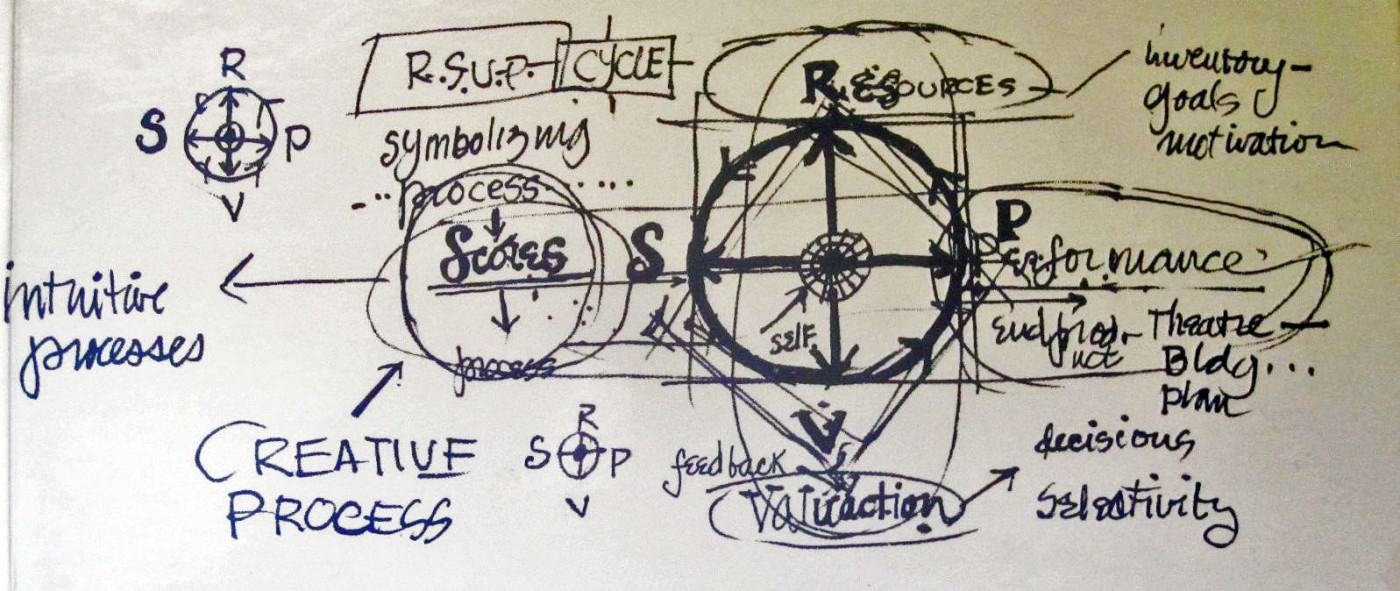
In visual form, Lawrence Halprin represents the R.S.V.P. Cycles as a wheel with the four elements of the Cycles placed at equal distances along the outer rim of the wheel and connected via two double pointed arrows that cross at right angles through the center of the wheel. Another set of arrows circulates along the wheel’s circumference. This visual representation highlights a major strength of the model—its non-linear mobility. As an approach to creative development, decision-making, and collaboration, the R.S.V.P. Cycles have no single entry point, no prescribed order, and no rigidly choreographed or predetermined destination. “The cycle,” Halprin writes, “can start at any point and move in any direction. The sequence is completely variable depending on the situation, the scorer, and the intent.”[2] Wheels turn.
Valuaction
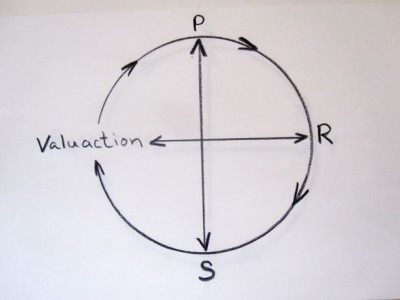 Using the lexicon of the R.S.V.P. Cycles, I embark on this reflection of CONSTELACIONES’ performance process as a valuaction. There are several things to consider about valuactioning: valuactions can take place at any stage of the scoring process; one valueacts according to the original intention of the score; it is important to “differentiate between valuacting the score itself or the performance of the score”; [3] and as Halprin writes: “The term ‘valuaction’ is one coined to suggest the action-oriented as well as the decision-oriented aspects of V in the cycle.” [4]
Using the lexicon of the R.S.V.P. Cycles, I embark on this reflection of CONSTELACIONES’ performance process as a valuaction. There are several things to consider about valuactioning: valuactions can take place at any stage of the scoring process; one valueacts according to the original intention of the score; it is important to “differentiate between valuacting the score itself or the performance of the score”; [3] and as Halprin writes: “The term ‘valuaction’ is one coined to suggest the action-oriented as well as the decision-oriented aspects of V in the cycle.” [4]
Valuaction was integral to our devising process. As each new performance element was added to the score-in-process, the group assessed the proposed element or action and made decisions based on its value in relation to the overarching intention(s) of the score, the personal, creative, and material resources needed to perform the action, and the aesthetic considerations of the collective. This written post-performance valuaction differs from that of our collective devising reflections in two significant ways: first, rather than focus on the value of our performance actions, my intention here is to reflect on the scoring process itself and how it functioned as a resource for our transnational creative collaboration; and second, though my focus is on CONSTELACIONES’ process, this valuaction is mine alone. Importantly, as with all gazes, mine is launched from, and informed by, my particular subject location—queer white settler Canadian artist-activist-scholar—within the complex constelacíon of artists that came together across what, on occasion, felt like incommensurably varied disciplinary, geographic, and geopolitical landscapes.
Through their public enactments, Return and Echoes brought the performances that CONSTELACIONES spent eight months preparing for into ephemeral moments of social visibility. The layered acts that went into their production, however, cannot be reduced to these moments. They were—are—part of a process that preceded—and exceeds—Return and Echoes’ public manifestations. With this valuaction, I seek to actively resist—refuse even—the notion of cathartic foreclosure that is too often associated with performance—or, put in neoliberal terms, the idea of performance as “product.” Alongside the archived documentation of Return and Echoes (here, in this collection, as well as through the Hemispheric Institute’s HIDVL digital archive) that extends their liveness beyond the fleeting temporality of their performance iterations, I undertake this reflection on their creation with a desire to extend and continue to learn from, the process itself.
January 26th, 2016
Blog reflection
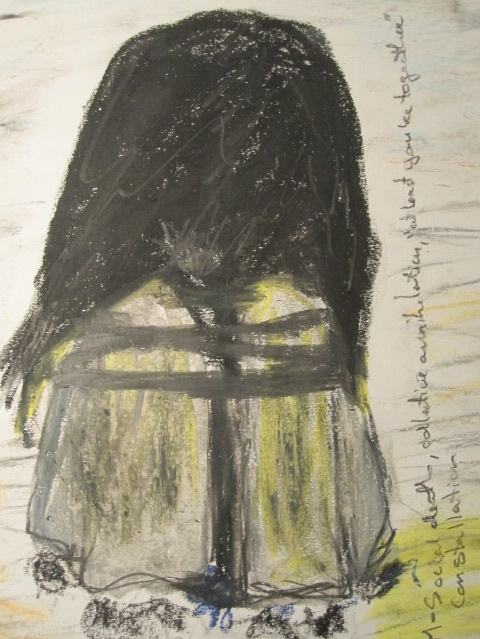 CONSTELACIONES Monica is our centre. We are bound by the gravitational force of her vibrant sculptural forms, her story, her exile, her journey of return. I imagine us—Roewan, Christina, Doris, and me—orbiting her. But three times now Monica has sculpted our bodies into a constellation. Each time she places us in close contact with one another. A proximity that intensifies as she physically molds and directs us until we form a tight embrace. And each time, at the close of our sculptural and kinesthetic tableau, Monica adds herself to our knotted—almost impenetrable—nucleus. I feel her arms as they wrap around us, pulling us closer yet, as though she is trying to shield and protect us. Or perhaps she is holding on against the centrifugal forces of exile.t
CONSTELACIONES Monica is our centre. We are bound by the gravitational force of her vibrant sculptural forms, her story, her exile, her journey of return. I imagine us—Roewan, Christina, Doris, and me—orbiting her. But three times now Monica has sculpted our bodies into a constellation. Each time she places us in close contact with one another. A proximity that intensifies as she physically molds and directs us until we form a tight embrace. And each time, at the close of our sculptural and kinesthetic tableau, Monica adds herself to our knotted—almost impenetrable—nucleus. I feel her arms as they wrap around us, pulling us closer yet, as though she is trying to shield and protect us. Or perhaps she is holding on against the centrifugal forces of exile.t
Resources
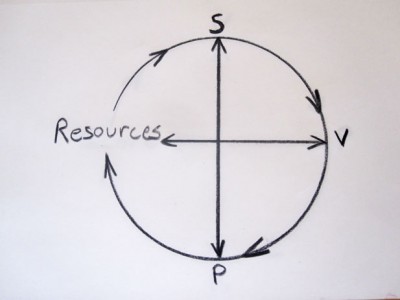 Within the R.S.V.P. Cycles, resources represent everything that is needed to generate and perform the score. Return’s imaginative ‘seed’ was Monica’s vision, dream, or hope that her sculptural installation—everyone is fallen except for us fallen—would one day come to rest in Northern Chile’s Atacama Desert—the place that inspired its creation. The gravitational force of Monica’s vision—further propelled by Doris’s introduction of Monica and Roewan—brought CONSTELACIONES together and shaped Return’s overarching intention: to return Monica’s vibrant forms to the Atacama Desert.
Within the R.S.V.P. Cycles, resources represent everything that is needed to generate and perform the score. Return’s imaginative ‘seed’ was Monica’s vision, dream, or hope that her sculptural installation—everyone is fallen except for us fallen—would one day come to rest in Northern Chile’s Atacama Desert—the place that inspired its creation. The gravitational force of Monica’s vision—further propelled by Doris’s introduction of Monica and Roewan—brought CONSTELACIONES together and shaped Return’s overarching intention: to return Monica’s vibrant forms to the Atacama Desert.
In addition to imaginative seeds, resources include the ground in which to plant them—the knowledge and abilities each participant is able to contribute, and the material elements necessary for their germination. CONSTELACIONES’ eclectic range of artistic capacities—sculpture, performance, theatre, sound, video arts, poetry, installation—provided us with rich soil in which to germinate Return and Echoes. Early in our scoring process, we worked on building our collective capacities by making visible our individual creative resources to the group. To gain a deeper intellectual and visceral understanding of the sculptural forms that were at the center of Return, Monica shared her MFA thesis with us and led us through a sculpting workshop. Roewan created a ‘discovery’ score where she guided us through a senses-based investigation of the forms. Doris and I led a series of movement explorations to generate shared gestural lexicons. Christina extended her visual arts practice to the group by creating a journal-blog for us to share visual and poetic reflections with one another.
As with the artistic resources needed to manifest Return and Echoes, the structural resources required were multiple. While it is beyond the scope of this essay to provide an accurate accounting of the structural resources that we collectively brought to the table and/or conjured, I offer this incomplete list: Roewan, Monica, and Christina wrote grants; Monica maintained a part-time position with Fed-X so she could access a much-needed reduced rate for shipping her sculptures; Christina, Roewan, and Doris hashed out the details of our Return itinerary; Christina made travel arrangements; Doris translated and found Marcello, our amazing driver (who also agreed to accept delivery of and store the six large boxes of forms once they made it through customs); I introduced the group to scoring as a communication and devising mechanism that could be used to facilitate and document our evolving process.
Score
 Map, shopping list, sale’s flyer, instruction manual, blueprint, image, to-do list—anything that can be used to convey or guide participant involvement in an action, or a performance, can be considered a score. Scores can be open or closed, informal or formal. They may be loosely focused explorations intended to generate performance resources, or detailed instructions designed to convey decided upon performance actions.
Map, shopping list, sale’s flyer, instruction manual, blueprint, image, to-do list—anything that can be used to convey or guide participant involvement in an action, or a performance, can be considered a score. Scores can be open or closed, informal or formal. They may be loosely focused explorations intended to generate performance resources, or detailed instructions designed to convey decided upon performance actions.
We needed a devising method that could serve as a means of communicating across vast ranges of creative vocabularies. Likewise, since throughout the development of Return and Echoes it was a rare occasion when all members of CONSTELACIONES were able to be physically present, rarer yet, that we were able to actually try out, or ‘rehearse’ together, our scoring document also had to serve as a method of communicating across geographies.
The ‘score-chart’ served as a mechanism for making our Return and Echoes scores interactive living documents that could be accessed and contributed to across space. The chart consisted of an upper section with bulleted lists of intentions, notes, things to work on or bring, and a table organized into three columns—Action; Details; and Resources—and rows whose number was determined by the distinct action sequences that made up the performance.
Part organizational document, part storyboard, part poem, the chart was in a constant state of development and refinement by all members of the collective. Questions were added, concepts and vocabularies clarified, resource needs identified. The score-chart provided everyone in the collective with a means of engaging in the process; allowed us to keep our devising conversations fluid and transparent; and made the labours and resources that would be needed to perform the score visible to everyone. Members of the collective contributed to the ongoing development of Return and Echoes via Skype conversations and by reviewing and refining—valueacting—the evolving score which was available in our group dropbox folder. Frequently, during Skype conversations, as well as in-person scoring sessions, we did mini-performances to clarify intentions and to arrive at shared movement and performance vocabularies.
Performance(s)
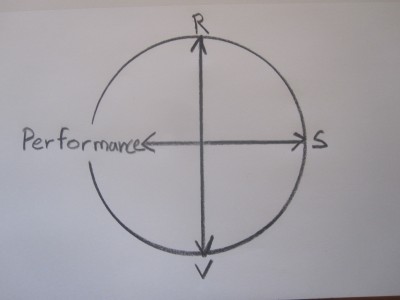 In the context of the R.S.V.P. Cycles, performance is never a singular or isolated event—it is a relational process that is part of the larger creative cycle. As Worth and Poyner write: “The term ‘Performance’ is used broadly to refer to putting the score into action and therefore includes ‘performances’ taking place during workshops, rituals and rehearsals.” [5] In the broadest sense, the performances that contributed to the development of Return and Echoes’ production include not only the creative labours that went into the score’s creation, but also a multiplicity of labours—relational, physical, emotional, intellectual, mundane, bureaucratic. Getting to know each other, tending to relationships, sharing food and tea, holding day-to-day frustrations and feelings, keeping up morale; wrapping, packing, and weighing the forms; scheduling meetings, writing agendas, taking minutes, translating, making travel arrangements, documenting explorations, writing grants, cleaning the studio, researching materials and locations, making costumes and props, sending and responding to emails, reading and adding comments to the score chart…
In the context of the R.S.V.P. Cycles, performance is never a singular or isolated event—it is a relational process that is part of the larger creative cycle. As Worth and Poyner write: “The term ‘Performance’ is used broadly to refer to putting the score into action and therefore includes ‘performances’ taking place during workshops, rituals and rehearsals.” [5] In the broadest sense, the performances that contributed to the development of Return and Echoes’ production include not only the creative labours that went into the score’s creation, but also a multiplicity of labours—relational, physical, emotional, intellectual, mundane, bureaucratic. Getting to know each other, tending to relationships, sharing food and tea, holding day-to-day frustrations and feelings, keeping up morale; wrapping, packing, and weighing the forms; scheduling meetings, writing agendas, taking minutes, translating, making travel arrangements, documenting explorations, writing grants, cleaning the studio, researching materials and locations, making costumes and props, sending and responding to emails, reading and adding comments to the score chart…
For the purpose of this article, however, I want to talk about how we approached performance in the form of embodied creative action. Performing—or placing one’s body and actions on display—is always a vulnerable act. Unlike some of the specialized creative resources individual CONSTELACIONES members contributed to our scoring process, performing in Return and Echoes was something every member of the collective committed to doing regardless of whether they considered performance part of their personal creative repertoire. In fact, the spectrum of performance experience, and genre, among the five of us was vast: Doris had experience as a professional actor, director, and workshop facilitator. I had experience as a performance artist and a movement-based expressive arts therapy instructor. Roewan’s interdisciplinary arts practice included experimental video performance and performance art. ‘Performative interventions’ were part of Monica’s experimental sculptural practice. Christina had some spoken word performance experience.
Coming from those with little movement-based performance experience, the commitment to participate in an ensemble that would perform both Return—a durational performance ritual––and Echoes—an “experimental opera” to be presented to an international performance-savvy audience—was an immense act of faith in the collective process. To honour this trust required attention and care. One way we did this was by actively working against the internalization and privatization of fears and insecurities. Instead of hindrances to be self-consciously hidden away, once voiced, fears and insecurities became valuable resources that helped us demystify ‘performance’ and prompted us to score a series of performance explorations.
Often, in conventional theatre or dance rehearsals, performers are provided with predetermined scripts or choreographed movements, and are directed toward the goal of performing technical virtuosity. Our performance explorations differed in both form and intent. Explorations were designed to generate and share movement vocabularies. Our goal was to support collective members to develop a sense of agency and presence when engaging in embodied creative actions, and to develop a collective repertoire that was accessible to everyone, regardless of prior performance experience. Facilitated movement and sense-based experiential exercises were often followed by loosely scored improvisational performances that enabled participants to expand their comfort with performance and creative risk-taking and helped us develop a shared repertoire. The attention and care we put into supporting the collective’s more novice performers is evidenced in the resources column of our score-chart, which included lists of strategies for navigating uncertainty and reminders of movement resources we generated as a group.
In addition to the range in performance experience and method among members of the collective, another major challenge throughout our creative process was distance. During the time we devised the scores for Return and Echoes, Roewan, Christina and Monica lived in Winnipeg, Doris in San Cristóbal de las Casas, Mexico, and I lived in Toronto. Most of CONSTELACIONES’ performance explorations took place in Roewan’s studio space at the Arlington. Though no substitute for in-person engagement, the score-chart, journal-blog, and Skype meetings were intended to provide at-a-distance access to the group process for Doris and myself. What we didn’t fully anticipate, however, was the differential allocation of digital access across geographies. I lived in Toronto and had reliable Internet access. Doris, on the other hand, who was traveling delivering performance workshops throughout Latin America for part of the year, had periods of limited or no Internet access. Likewise, whereas thanks to structural support provided by my CCPPA Postdoctoral Fellowship and my Winnipeg-based family, I was able to make three trips for week-long in-person intensives in Winnipeg, Doris was only able to join one of our intensives.
Lake Winnipeg
Since Return was to be a site-specific performance, we decided to set out on a loosely structured environment-based performance adventure during one of my visits. We hired photographer Lindsey Bond to document our explorations to help us reflect on and glean performance resources from the experience and as a means of sharing the experience with Doris, who was unable to come. We chose frozen Lake Winnipeg because of its paradoxically stark similarities and differences to the Atacama Desert. Both are dry sparse landscapes with vast horizons. Both are spaces where the elements—wind, sun, ice, sand, sky, light, shadow, cold, heat—dominate the senses. Our score was informal, open, and designed to give everyone an opportunity to initiate a site-specific movement exploration or kinesthetic tableau. We agreed on a monochrome colour palette for our dress and, in addition to bringing some of Monica’s forms, we each brought props of our choosing. Monica brought a role of burlap—the same cloth she had used to wrap the forms in before she committed them to the kiln’s heat. Christina brought a bouquet of plastic pink flowers—reminiscent of the stunning Atacama Desert blossoming in spring of 2015—and knitting. Roewan brought shovels. I brought twine.
Taken together, the embodied memory and the documentation of our Lake Winnipeg kinesthetic tableaus served as powerful resources. They instilled a sense of confidence and agency in our individual and collective performance capacities. This was especially crucial for those members of the collective who were new to movement-based performance. One way that the R.S.V.P. Cycles engender empowerment in both novice and more experienced performers is in the creative spaciousness the process generates. Naming and distinguishing four distinct—and interanimating—elements of the process allows each aspect to breathe in its own right. Allotting valuacting its own space, for example, encourages performers to commit to the score by reminding themselves that there will be time for reflection and valuaction—after the performance. In my experience of facilitating movement explorations with untrained performers, I find this invitation to set aside the internal ‘judge’ who is incessantly assessing aesthetic value an invaluable resource. As Christina writes in a post Lake Winnipeg reflection: “I continuously attempted to push back the discomforts in my head that I was an imposter or that I wasn’t sure what I was doing and why. I fought back with agency. That I could use my body in whatever way I wanted, and that in fact, in my warm rewarding shower afterwards, I felt like I had had a revelation in something so obvious as allowing my body to move in unprescribed ways.”
Over time, through the process of collectively valuacting our Lake Winnipeg performances, we identified gestural, spatial, and image resources that we later scored into our Return and Echoes performances: ice met with sand in Echoes’ ‘time suspended sand & ice sculpture”; Christina’s pink flowers and my black twine are reflected in the snake-like wind sculpture we created in the Atacama Desert from the packing materials that had been used to wrap the sculptural forms for shipping; Roewan’s gesture of digging in snow gesture was transformed in Echoes into a gesture where we each dug with our fingers to tear open our individual pouches of sand attached to our bodies as an act of gritty release; and Monica’s Lake Winnipeg exploration of wrapping and unwrapping the group met with Return’s wrapping remains wind sculpture, to create the five-headed bubble wrap creature from Echoes’ opening scene.
Wrapping/Unwrapping: Gestures of Necessity. Gestures of Care. Gestures of Release.
Of the many gestures—carrying, holding, walking, bending, reaching, touching, cradling, digging, pulling, spinning, looking—that constituted Return and Echoes performance vocabularies, wrapping and unwrapping were two that became integral to both our culminating performances and our creative process. When Monica shared with us her process of creating the installation that, eight months later, CONSTELACIONES would release in the Atacama Desert, I was struck by the layered meanings and affective valence of her gesture of wrapping the porcelain bone like cross forms with their fabric imprinted terracotta bindings. In addition to being essential to the physical construction of the cross-like forms, Monica’s “meditative act” of wrapping referenced Pinochet-era burial shrouds and the “shroud clad Incan mummies found in the Andes,” and symbolized “the care that should have been given to the violated dead.”
As with Monica’s gesture of wrapping the forms and the ritualized act of wrapping with a a shroud, throughout our creative process our gestures of wrapping came to signify acts of care. Also, like Monica’s binding of the porcelain bones with fabric-like terracotta strips, wrapping was at times a gesture of necessity. In order to ship the forms to Chile, they needed to be wrapped. It was a precarious and uncertain labour. We didn’t know if they would arrive intact or be detained at customs. We didn’t know if we would see them again. The perilousness of their journey weighed most heavily on Monica who spent years gestating, creating, and living with these intricately textured ceramic forms. To honour the gravity of Monica’s gesture of release, CONSTELACIONES created a participatory performance event we called Wrapping Atacama. We invited family, friends, and allies from our Winnipeg communities to share the weight of the necessarily careful labour of wrapping the fragile forms and, as they did so, to reflect on what it means to gather around those who have experienced the trauma of displacement, separation, and perilous journeys.
Unlike the final gesture of wrapping a shroud, the gesture of wrapping, for us, necessitated another gesture—unwrapping. After Monica wrapped us together at Lake Winnipeg, to release us she unwrapped us. Likewise, each painstakingly wrapped form had to be unwrapped before we could release them to the Atacama Desert. The interplay between wrapping and unwrapping continued throughout our performance process. To take care that our packing materials were not dispersed by the desert winds as trashy remains we scored the construction of Return’s “bubble wrap remains sculpture,” in which each piece of bubble wrap was bound with twine. We used this remains sculpture in Echoes. Each holding a bundle of the packing remains sculpture in our arms, we wound ourselves into a single creature—a revisiting of Monica’s Lake Winnipeg wrapping tableau. Then, as on Lake Winnipeg, Monica released us from our collective binding. This time, it was a negotiated release as each of us considered what it would be like to be suddenly unfurled, no longer connected, sent spinning. Do we struggle to hold on? Resist releasing our bundled remains? Reluctantly orbit into an unknown galaxy?
Wheels Turn
A key political principle of the R.S.V.P. Cycles is to make visible as many elements of the creative process as possible to all who are participating in it. While this visibility does not presume equity of either access or investment, it endeavours to provide a transparent mechanism for engagement. With this valuaction, I have sought to make visible to a broader audience some of the ways we used the R.S.V.P. Cycles’s intersecting and mobile components in our collective devising process. Needless to say, it is not possible to ever fully illustrate a creative process. Instead, I have offered these traces—artifacts and glimpses—of the devising journey that went into Return and Echoes’ productions. My intention has been twofold: to resist the notion of cathartic foreclosure associated with performance by shifting the gaze from performance to process; and to extend and continue to learn from that process. As a project-based artist collective, CONSTELACIONES is no longer bound by the gravitational pull of our initial overarching intention—to return Monica’s forms to the Atacama Desert. What traces do we take with us as we unfurl into new creative orbits? What remains?
Notes
[2] Ibid., 2.
[3] Libby Worth and Helen Poyner, Anna Halprin (New York: Routledge, 2004), 179.
[4] Halprin, 4.
[5] Worth and Poyner, 72 – 72.
[1] Lawrence Halprin, The RSVP Cycles: Creative Processes in the Human Environment (New York: George Braziller, Inc. 1969).
[2] Halprin, 2.
[3] Libby Worth and Helen Poyner. Anna Halprin (New York: Routledge. 2004), 179.
[4] Halprin, 4.
[5] Worth and Poyner, 72 – 72.

